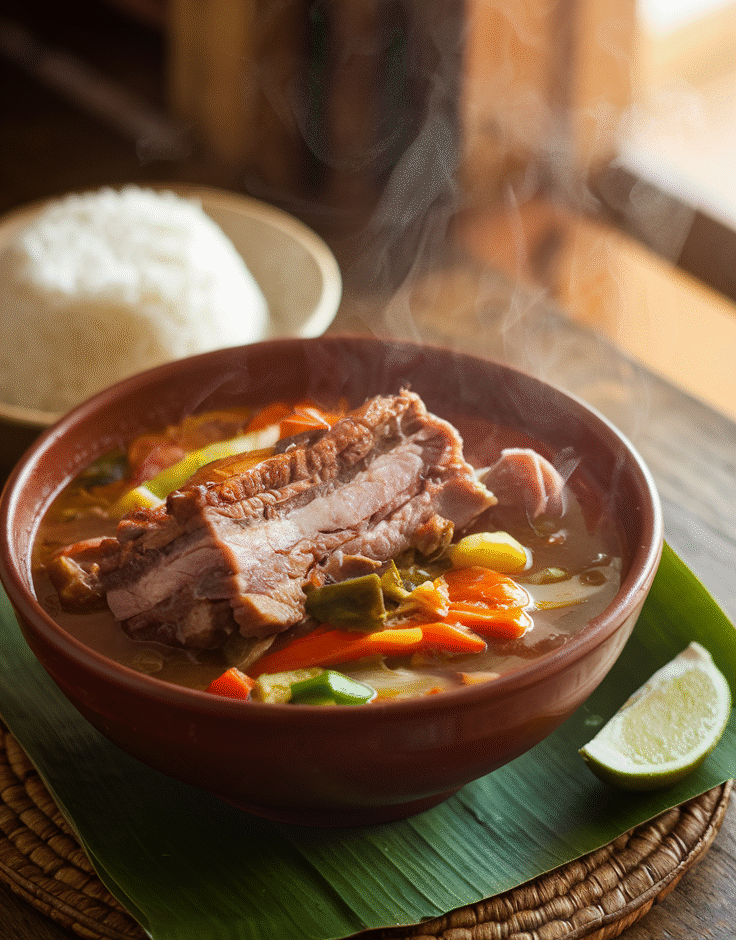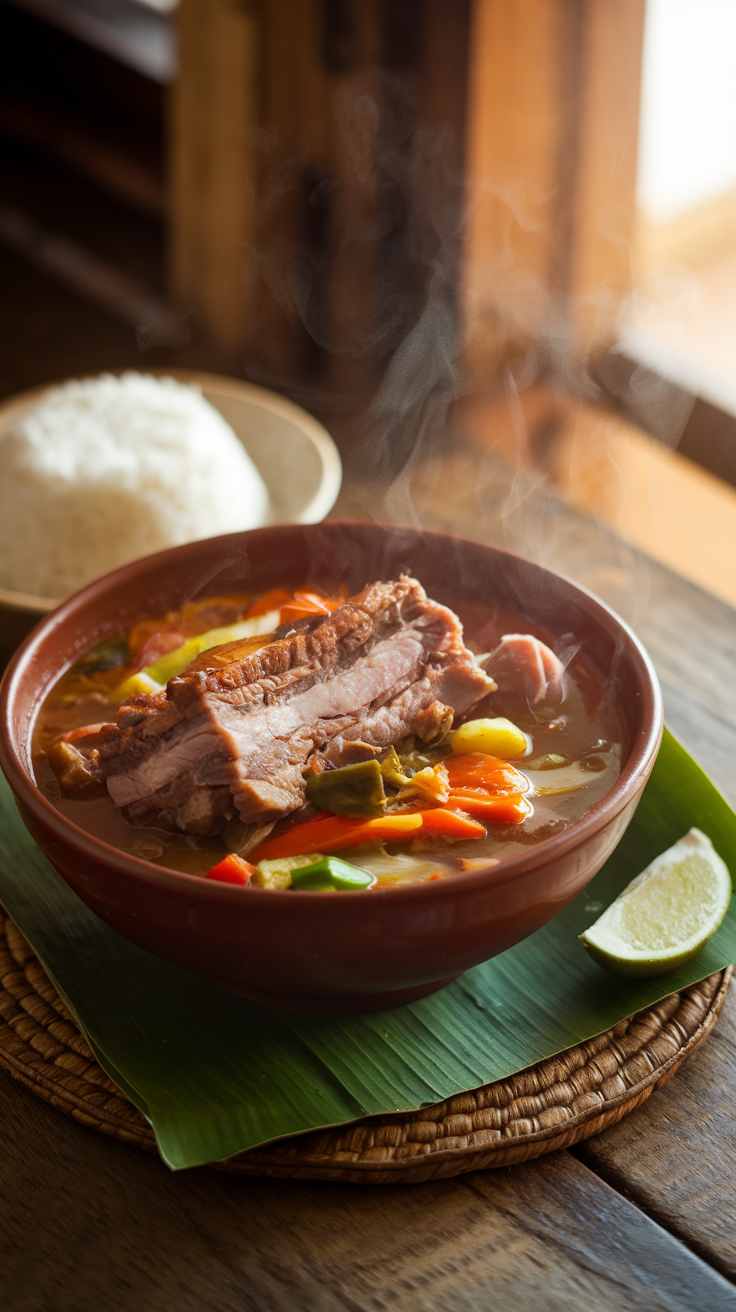
- Start by browning the pork (this is crucial)
Heat 2 tablespoons oil in a large, heavy-bottomed pot over medium-high heat. Add the 2 lbs pork shoulder chunks and brown on all sides, about 8-10 minutes total. Don't overcrowd, work in batches if needed.
- Add the aromatics to the browned pork
Toss in the quartered onion and quartered tomatoes. Cook for 3-4 minutes until the tomatoes start to break down and release their juices. The bottom of your pot should be getting all golden and delicious.
- Pour in the water and bring to a boil
. Add exactly 8 cups water to the pot, scraping up any browned bits from the bottom, that's flavor gold right there. Bring everything to a rolling boil over high heat.
- Add fish sauce and reduce to simmer
Stir in 2 tablespoons fish sauce, then reduce heat to low and cover. Let this simmer gently for 1 hour, skimming off any foam that rises to the surface occasionally.
- Add the tamarind base and harder vegetables
After 1 hour, stir in your tamarind soup base packet (or tamarind paste). Add the thick-sliced daikon radish first since it takes the longest to cook. Simmer for another 15 minutes.
- Add green beans and eggplant
Toss in the 2-inch green bean pieces and thick-sliced Asian eggplant. These need about 10-12 minutes to become tender but not mushy. Keep that gentle simmer going.
- Add okra and season with salt
Add the trimmed okra and 2 tablespoons salt (or to taste). Cook for another 5 minutes, okra cooks quickly and you don't want it turning to complete mush.
- Finish with greens and chilies
In the last 2 minutes, add the fresh spinach and long green chilies. The spinach will wilt almost instantly, and the chilies just need to heat through to release their flavor without becoming overpowering.
- Taste and adjust the sourness
This is your moment to make it perfect, add more tamarind if you want it more sour, more salt if it needs depth, or more fish sauce for umami. The flavor should be bright, tangy, and well-balanced.
- Serve immediately in large bowls
Ladle generous portions into bowls, making sure everyone gets a good mix of pork, vegetables, and that gorgeous sour broth. Serve alongside steamed jasmine rice.
- Set up the table with condiments
Place small dishes of fish sauce and sliced chilies on the table so people can adjust their bowls to their liking. This is part of the sinigang experience, customizing your perfect bowl.
- Enjoy while hot
Sinigang is best eaten immediately while everything is steaming hot and the vegetables still have a bit of bite to them.
- For Serving
Steamed jasmine rice
Fish sauce for individual seasoning
Extra sliced chilies
- Calories:385 kcals
- Fat:18 grams
- Proteins:28 grams
- Carbohydrates:24 grams
Picture this: you’re having one of those days where everything feels off, and then someone hands you a steaming bowl of Pork Sinigang with that perfect balance of tangy, savory, and “holy-moly-this-is-exactly-what-I-needed” comfort. This Filipino classic isn’t just soup, it’s like liquid therapy that happens to taste incredible and comes loaded with tender pork and fresh vegetables that make you feel good about eating your greens.
Why This Pork Sinigang Recipe is Awesome
Pork Sinigang is basically the Filipino equivalent of chicken soup, except it’s way more interesting and packs a tangy punch that’ll wake up your taste buds from whatever food coma they’ve been in. Moreover, this isn’t one of those fussy recipes that requires you to source ingredients from seventeen different specialty stores, most of what you need is probably hanging out in your regular grocery store right now.
What makes this dish absolutely genius is how the tamarind creates this bright, sour base that somehow makes everything else taste more like itself. Furthermore, it’s one of those magical one-pot wonders where you throw a bunch of stuff in, let it bubble away, and emerge hours later looking like a culinary wizard.
Best part? This soup actually gets better the next day, which means you can meal prep like a boss or just have something amazing waiting for you when you’re too tired to think about cooking. Plus, it’s loaded with vegetables, so you can feel virtuous while slurping something absolutely delicious.
Common Mistakes to Avoid
Skipping the pork browning step is like building a house without a foundation, you’ll miss out on all that deep, caramelized flavor that makes the difference between good sinigang and great sinigang. Additionally, adding all the vegetables at once is a rookie mistake that’ll leave you with mushy vegetables and crunchy vegetables in the same pot.
Using too much tamarind right off the bat can make your soup mouth-puckeringly sour with no way to fix it. Start with less and build up to your preferred tartness. Moreover, not tasting and adjusting at the end means missing the chance to create that perfect balance of sour, salty, and savory.
Overcooking the greens turns beautiful spinach into sad, olive-colored mush that nobody wants to eat. They should be bright green and just wilted.
Finally, not having rice ready is like having a car without gas, technically possible but completely defeating the purpose. Sinigang and rice are a team, don’t split them up.
Alternatives & Substitutions
Can’t find tamarind soup base? Fresh tamarind paste works great, or you can use calamansi juice mixed with a bit of vinegar for a different but still delicious sourness. No daikon radish? Regular radishes or even turnips work, though the flavor will be slightly different.
Pork shoulder too expensive? Pork ribs make an excellent substitute and actually add more flavor to the broth, just increase the cooking time by 30 minutes. Vegetarian version? Use firm tofu or tempeh instead of pork, and substitute vegetable stock for water plus soy sauce instead of fish sauce.
Can’t find Asian eggplant? Regular eggplant works fine, just cut it into larger pieces since it tends to break down more. No kangkong/water spinach? Regular spinach, bok choy, or even cabbage work as substitutes.
Fresh tamarind paste substitute? In a pinch, you can use white vinegar with a tiny bit of brown sugar, but it won’t have that distinctive tamarind flavor that makes sinigang special.
Frequently Asked Questions About Pork Sinigang
Q: How sour should sinigang actually be? A: It should be noticeably tangy but not face-puckeringly sour. Think “bright and refreshing” rather than “lemon-sucking grimace.” Everyone’s preference is different, so adjust to your taste.
Q: Can I use a pressure cooker for this? A: Absolutely! Brown the pork first using the sauté function, add aromatics and liquid, pressure cook for 45 minutes, then quick release and add vegetables in stages with manual cooking.
Q: My soup isn’t clear, is that wrong? A: Nope! Sinigang can range from clear to slightly cloudy depending on how vigorously you simmer and what vegetables you use. Both are perfectly authentic.
Q: How long does this keep in the fridge? A: The soup lasts 4-5 days in the fridge and actually tastes better the next day. Just reheat gently and maybe add fresh greens if the original ones got too soft.
Q: Can I freeze leftover sinigang? A: The broth and pork freeze well for up to 3 months, but the vegetables get mushy when thawed. Better to freeze just the broth and pork, then add fresh vegetables when reheating.
Q: What if I accidentally made it too sour? A: Add a bit more salt and maybe a tiny pinch of sugar to balance it out. You can also dilute with more water or broth, though you might need to re-season everything.
Q: Is there a specific type of pork that works best? A: Pork shoulder or pork belly work beautifully because the fat keeps the meat tender during long cooking. Avoid lean cuts like tenderloin, they’ll just dry out and get tough.
Final Thoughts About Pork Sinigang
There you have it, Pork Sinigang that’ll transport you straight to Filipino comfort food heaven, whether you’ve been there before or you’re taking your first delicious journey. This soup proves that sometimes the most satisfying dishes are the ones that embrace bold, distinctive flavors instead of playing it safe.
The beauty of sinigang lies in its perfect balance of elements, the rich pork, the bright sourness, the fresh vegetables, and that soul-warming broth that somehow makes everything better. Furthermore, it’s the kind of dish that brings people together around the table, encouraging conversation and that wonderful communal feeling of sharing something truly special.
So grab your biggest pot, embrace the tang, and get ready to make something that’ll have everyone asking for seconds (and thirds, and maybe fourths). Your kitchen is about to smell absolutely incredible, and your taste buds are in for a treat. Now go forth and create some sour, savory magic.










